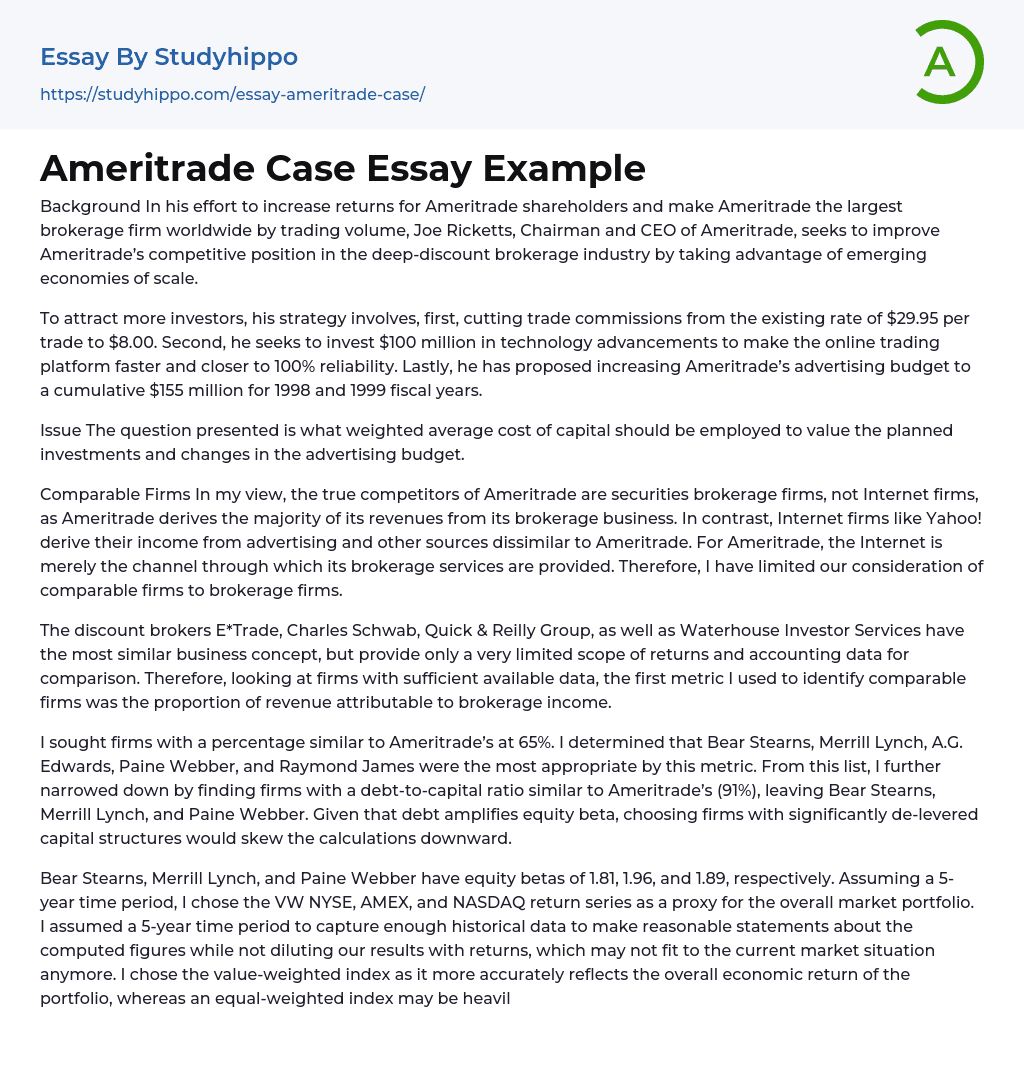Joe Ricketts, the Chairman and CEO of Ameritrade, has a goal to improve Ameritrade's competitiveness in the deep-discount brokerage industry and generate higher returns for shareholders. His strategy involves leveraging emerging economies of scale to establish Ameritrade as the top global brokerage firm in terms of trading volume.
He has a strategy to attract more investors, which includes several measures. Firstly, he intends to decrease trade commissions from $29.95 per trade to $8.00. Secondly, he plans to allocate $100 million for technology advancements in order to enhance the speed and reliability of the online trading platform. Lastly, he proposes increasing Ameritrade's advertising budget to a total of $155 million for the fiscal years of 1998 and 1999.
Issue: The question at hand is determining the appropriate weighted average cost of capital to use when evaluating the planned investments and adjustments to the advertising
...budget.
According to my perspective, the main rivals of Ameritrade are securities brokerage firms rather than Internet firms. This is because Ameritrade generates most of its revenue from its brokerage business. Unlike Ameritrade, Internet firms like Yahoo! make their income from advertising and other sources that are different from Ameritrade. The Internet is simply the medium through which Ameritrade offers its brokerage services. Consequently, I have narrowed down our evaluation of similar companies to brokerage firms.
E*Trade, Charles Schwab, Quick & Reilly Group, and Waterhouse Investor Services are discount brokers with a similar business concept. However, their scope of returns and accounting data for comparison is very limited. To identify comparable firms with sufficient available data, the first metric I considered was the proportion of revenue derived from brokerage income.
Among the firms I found, Bear Stearns
Merrill Lynch, A.G. Edwards, Paine Webber, and Raymond James had a similar percentage to Ameritrade's of 65%. Next, I refined the list by identifying firms with a debt-to-capital ratio comparable to Ameritrade's 91%, resulting in Bear Stearns, Merrill Lynch, and Paine Webber as potential options. It is crucial to select companies with de-levered capital structures to prevent underestimating calculations since debt increases equity beta.
The equity betas for Bear Stearns, Merrill Lynch, and Paine Webber are 1.81, 1.96, and 1.89 respectively. These figures were analyzed over a 5-year time period using the VW NYSE, AMEX, and NASDAQ return series as a proxy for the overall market portfolio. The reason for selecting a 5-year time period was to ensure enough historical data for accurate calculations and to avoid including outdated returns that may not accurately reflect the current market situation. The value-weighted index was chosen over an equal-weighted index because it provides a more accurate representation of the overall economic return of the portfolio and avoids excessive influence from a single security regardless of its market power.
Due to the limited price history of Ameritrade, spanning only 6 months and resulting in 5 returns, I decided to use the average beta of similar companies (1.89) as the equity beta. Calculating the beta based on the provided return figures for Ameritrade would be misleading (-1.36).
Exhibit 1 displays the asset betas of several comparison firms: Bear Stearns, Merrill Lynch, Paine Webber, and Ameritrade. The asset betas for Bear Stearns, Merrill Lynch, and Paine Webber are 0.87, 0.85, and 0.93 respectively. In contrast, Ameritrade has an asset beta of 0.39. The significant disparity in these values is attributed to Ameritrade's considerably
high debt/capital ratio when compared to the aforementioned firms.
Relative Inputs for Calculation of Cost of Capital
As previously mentioned, when calculating Ameritrade's equity beta, I took the average beta of three comparable firms due to insufficient information to accurately calculate Ameritrade's own beta. Utilizing a 5-year time horizon and considering the annualized market return and annualized return of 5-year bonds over the course of the last 46 years, we employed the CAPM to estimate the equity cost of capital at 0.32.
For the return on debt, I used a rate of 8.5%, which was based on Ameritrade managers reporting borrowing costs of 8-9%. In 1997, Ameritrade had an approximate tax rate of 35%.
By utilizing the provided information, I computed a weighted average cost of capital to be 0.08. The relatively low value is primarily attributed to Ameritrade's significant debt/capital ratio, resulting in a decreased emphasis on the cost of equity.
- Futures Contract essays
- Mortgage Loan essays
- Renting essays
- Transaction Cost essays
- Asset essays
- Depreciation essays
- Discounted Cash Flow essays
- Foreign Direct Investment essays
- Funds essays
- Internal Rate Of Return essays
- Revenue essays
- Day Trading essays
- Futures Trading essays
- Capital market essays
- Million essays
- Payment essays
- Rate Of Return essays
- Funding essays
- Hedge Fund essays
- Buying Homes essays
- Bank essays
- Banking essays
- Corporate Finance essays
- Credit Card essays
- Currency essays
- Debt essays
- Donation essays
- Enron Scandal essays
- Equity essays
- Financial Accounting essays
- Financial Crisis essays
- Financial News essays
- Financial Ratios essays
- Financial Services essays
- Forecasting essays
- Foreign Exchange Market essays
- Free Market essays
- Gold essays
- Investment essays
- Legacy essays
- Loan essays
- Market Segmentation essays
- Money essays
- Personal finance essays
- Purchasing essays
- Retirement essays
- Shareholder essays
- Stock Market essays
- Supply And Demand essays
- Venture Capital essays




